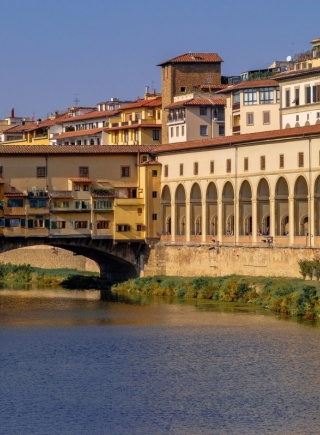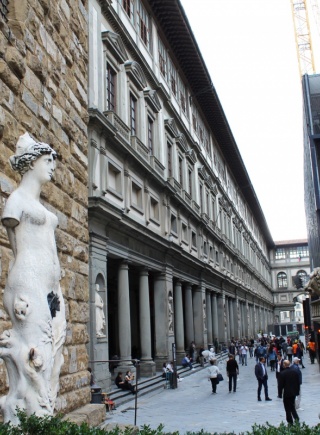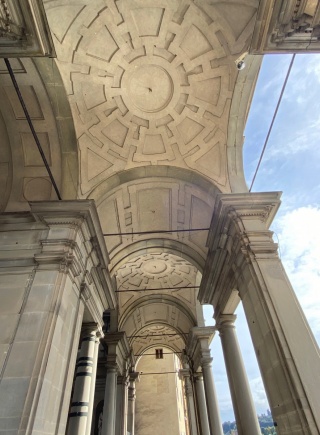History of the Uffizi Museum in Florence
The Uffizi Gallery, how the great Florentine museum was born
The Uffizi and the Medici a long and fascinating history that forever binds one of the most important museums in the world to the Medici dynasty. The Medici were the family that for some centuries ruled Florence making it one of the richest cities in art and undisputed beauty.
The history of the Uffizi is linked to the figure of one of the greatest exponents of the Medici family, Cosimo I, the second and last Duke of Florence, who came to power in 1537. Cosimo took up residence in Palazzo Vecchio and from that moment began his policy of exalting the his figure of "monarch" in the context of the city of Florence. It was in 1560 that Cosimo decided to unite the 13 Florentine magistracies in a single seat under his strict supervision, a few steps from the government headquarters of Palazzo Vecchio. He then instructed Giorgio Vasari to build a large palace between the Palazzo della Signoria and the embankment of the Arno river that could accommodate all the administrative offices of Florence (hence the name of Uffizi) previously located in various locations. The palace would thus have guaranteed to centralize the control of the administration of Florence in the hands of the Medici lordship, at the same time enhancing its prestige and undisputed power.
The Uffizi Palace was built between 1560 and 1580.
Vasari had first to solve the problem of the limited space he had available to place the palace in that narrow area. Vasari thus decided to build a tall building in the shape of an elongated U, obtaining two exceptional results at the same time: solving the problem of limited space and obtaining a scenographic effect of great impact.
Galleria degli Uffizi
Scopri di più
 What is the Uffizi museum - the most visited museum in Florence
The Uffizi museum or more correctly the Uffizi Gallery is a state museum located in Florence, in the homonymous building.The Uffizi are undo...
Read More
What is the Uffizi museum - the most visited museum in Florence
The Uffizi museum or more correctly the Uffizi Gallery is a state museum located in Florence, in the homonymous building.The Uffizi are undo...
Read More
 The Uffizi and the Vasari Corridor
The Vasari Corridor represents one of the most exclusive attractions among the artistic treasures of the city of Florence. A true architectu...
Read More
The Uffizi and the Vasari Corridor
The Vasari Corridor represents one of the most exclusive attractions among the artistic treasures of the city of Florence. A true architectu...
Read More
 The Palazzo degli Uffizi in Florence - the seat of the Museum
Visiting the Uffizi Gallery in Florence is not just admiring the art treasures that the Florentine museum contains. The Palazzo degli Uffizi...
Read More
The Palazzo degli Uffizi in Florence - the seat of the Museum
Visiting the Uffizi Gallery in Florence is not just admiring the art treasures that the Florentine museum contains. The Palazzo degli Uffizi...
Read More
 Where are the Uffizi and how to get there
The Uffizi Gallery is located in the historic center of Florence, between Piazza della Signoria and Ponte Vecchio, therefore in the heart of...
Read More
Where are the Uffizi and how to get there
The Uffizi Gallery is located in the historic center of Florence, between Piazza della Signoria and Ponte Vecchio, therefore in the heart of...
Read More
 Why it is important to book a visit to the Uffizi in advance
The Uffizi Museum is undoubtedly one of the most visited places of culture in Europe and therefore always besieged by thousands of tourists....
Read More
Why it is important to book a visit to the Uffizi in advance
The Uffizi Museum is undoubtedly one of the most visited places of culture in Europe and therefore always besieged by thousands of tourists....
Read More
 Tour Privato alla Galleria degli Uffizi
This is a personalized experience in close contact with the museum in the company of an art historian. The private guided tour lasts about 3...
Read More
Tour Privato alla Galleria degli Uffizi
This is a personalized experience in close contact with the museum in the company of an art historian. The private guided tour lasts about 3...
Read More
 Services and useful information on the Uffizi Museum
The Uffizi museum in Florence has been recently renovated, enlarged and refurbished to allow visitors to make the most of the museum spaces....
Read More
Services and useful information on the Uffizi Museum
The Uffizi museum in Florence has been recently renovated, enlarged and refurbished to allow visitors to make the most of the museum spaces....
Read More
 How to organize a visit to the Uffizi Gallery in Florence
What to book to see the Uffizi? How much does it cost to enter the Uffizi? these are questions that do not correspond to a single answer.In...
Read More
How to organize a visit to the Uffizi Gallery in Florence
What to book to see the Uffizi? How much does it cost to enter the Uffizi? these are questions that do not correspond to a single answer.In...
Read More
 Facilitated routes at the Uffizi Gallery in Florence
The Uffizi Gallery offers an easy access for disabled visitors. By presenting the certificate of disability, you are entitled to free access...
Read More
Facilitated routes at the Uffizi Gallery in Florence
The Uffizi Gallery offers an easy access for disabled visitors. By presenting the certificate of disability, you are entitled to free access...
Read More
 Visit the Uffizi Gallery by booking a guided tour
Those who wish to live a more complete experience by visiting the Uffizi can decide to be accompanied on the tour by a guide in flesh and bl...
Read More
Visit the Uffizi Gallery by booking a guided tour
Those who wish to live a more complete experience by visiting the Uffizi can decide to be accompanied on the tour by a guide in flesh and bl...
Read More
 When is it advisable to visit the Uffizi Museum?
In 2019, the Uffizi Gallery in Florence was confirmed as the most visited museum in Italy and ranks in the world top ten of the most visited...
Read More
When is it advisable to visit the Uffizi Museum?
In 2019, the Uffizi Gallery in Florence was confirmed as the most visited museum in Italy and ranks in the world top ten of the most visited...
Read More
 Uffizi Gallery, visit the museum with the audio guide
At the Uffizi Gallery it is also possible to rent an audio guide at a cost of 7 euros combined with a skip-the-line entrance ticket. By rent...
Read More
Uffizi Gallery, visit the museum with the audio guide
At the Uffizi Gallery it is also possible to rent an audio guide at a cost of 7 euros combined with a skip-the-line entrance ticket. By rent...
Read More
The Uffizi Gallery houses the largest collection of paintings from Romanesque period to the 18th century. Nowadays the Uffizi still accommodates famous masterpieces exhibited in chronological order

